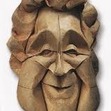Nick Robinson's Blog, page 41
October 20, 2011
It's all Greek to me…
[image error]My effervescent friend from Greece, Myrto Dimitriou, continues to blaze a trail of publicity for herself the work she does.
Her latest item was in the NOA magazine 534, where the was a report about the Spanish convention, replete with a photo of Brilly, Assia, Myrto and myself.
We had a fabulous time there and I'm guessing that's what the report says ;)
October 5, 2011
Everybody peck the dinosaur
I had a request recently from Dame Penny Groom, the president-elect of the BOS. For many years, she has supplied a monthly origami model for her local paper, the "Countesthorpe Herald" and regularly asks permission for use of one of my designs, which I'm delighted to grant.
This time it was for a "Pecking Pterosaur", which she'd seen in one of the origami calendars from the States. Soon after, I had another request from her son Paul, who wants to use the model for some kind of crazy-assed competition on twitter (whatever that is). So, I'm posting the diagram here for the twits to have a go at. "Enjoy", as my dear old friend Mark Kennedy said to me on countless occaisions.
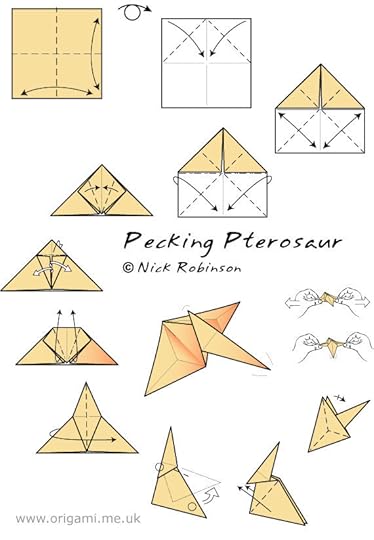
September 30, 2011
There's a Plaice for us, somewhere…
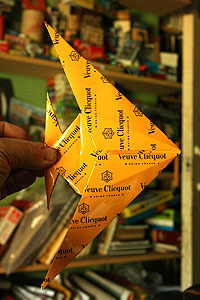 I was approached recently about a commission to produce 50 origami fish, about 12″ high, folded using paper branded with the logo of the client, Verve Clicquot. The design was by John Montroll, so I contacted him and arranged a suitable percentage for use of his work.
I was approached recently about a commission to produce 50 origami fish, about 12″ high, folded using paper branded with the logo of the client, Verve Clicquot. The design was by John Montroll, so I contacted him and arranged a suitable percentage for use of his work.
Then came the slight "tweaks" to the contract – the fish were to be hung from a wire outside the clients building, in Spain, and must be capable of resisting the worst that Spanish weather could throw at it, for a whole year, without fading. I was floundering somewhat and couldn't believe what I was herring!
Good Cod, I thought, I need to mullet over, but had to get my skates on. Eventually, I found the sole offset printers her in Sheffield who could print the pattern onto UPVC "paper" and trim to a suitably sized square. This material turned out to be remarkably appropriate, water and weatherproof, with an ultra-voilet coating to prevent fading as much as was possible.
I was turbot-charged and the folding was halibut over when the physical pressure needed to add a crease to plastic soon took its toll with some pulled tendons (Pollocks!) in my wrist slowing progress down somewhat as I wrassled with it. I'd haddock enough by the end, but didn't carp about it.
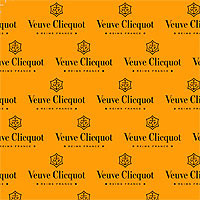 I had to mako a dozen or so models to refine my folding sequence. The creases themselves were fairly crisp, and perhaps surprisingly, could be reversed without difficulty. However, there was still a tendency to try and unfold. In the end, I layered them in a pile of 12″ albums (carefully chosen 80′s pop & classical) for a few days to carp them flat. It did help, although in the end I added a surreptitious staple.
I had to mako a dozen or so models to refine my folding sequence. The creases themselves were fairly crisp, and perhaps surprisingly, could be reversed without difficulty. However, there was still a tendency to try and unfold. In the end, I layered them in a pile of 12″ albums (carefully chosen 80′s pop & classical) for a few days to carp them flat. It did help, although in the end I added a surreptitious staple.
I'd considered ironing them between layers of fabric, but in the end didn't try it. The was breaming smile on my face, they looked brill and I was a dab hand at it.
Oh yes, I'm still waiting to be paid – these aren't the terms I usually goby…
September 14, 2011
Origami Design Secrets (second edition) : Robert Lang
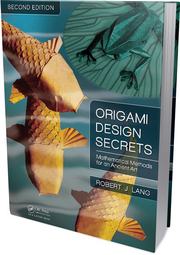 As ever, there's good news and bad news. The good news is that a second edition of Robert Lang's Origami Design Secrets" is available. The bad news is you're going to want to buy it, even if you have the first edition. Here's a brief summary from the author, detailing the main changes.
As ever, there's good news and bad news. The good news is that a second edition of Robert Lang's Origami Design Secrets" is available. The bad news is you're going to want to buy it, even if you have the first edition. Here's a brief summary from the author, detailing the main changes.
All figures have a new color scheme for better clarity
A few new diagrams: silverfish, elk, organist
More detailed instructions for the scaled koi
The original chapter 12 on box pleating is greatly expanded
Two new chapters (13 & 14) on polygon packing
Assorted small errors are corrected
The chapter on algorithms (with all the math formulas) has been
removed
Overall, 200 pages of new material have been added and the page count has increased from 584 to 758. It's quite rare that any publishers allow the author such leeway to revise a book, often you are limited to correcting mistakes. It's a tribute to both the author and the publisher (CRC Press) that such major updates have been allowed.
This book is without doubt the best guide to creating origami that has ever been published and I suspect it will retain the crown forever. Lang goes through the various techniques and methods one can use to create and adapt origami, with the exception of my own referred method, "Fold and Hope". Their are models and practical examples of techniques, all written in clear, accurate language. Quite simply, all creative folders should own this book if they have any interest in developing their skills. Even if they have no such interest, they should buy it – it's that good.
You (or your partner) may baulk at paying nearly £40 for a book, but 20 pages of expert guidance for a pound seems good value to me. In any case, ebay is likely to be full of people selling their first editions in order to replace with the second. Or maybe they will hedge their bets and wait for the 3rd edition, presumably with 1000 pages ;)
September 12, 2011
O-Gami paper for complex models
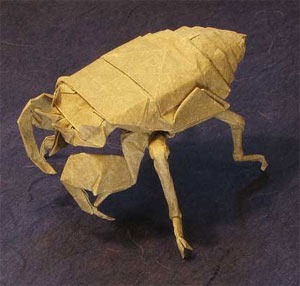
Cicada Nymph by Satoshi Kamiya, folded by Jon Tucker using O-Gami paper
I've had a message from the Director of Paper Circle in Ohio (a non-profit paper and book arts centre). Two years ago they were encouraged by the Columbus origami group Capital Area Paper Shapers to come up with paper for wet folding and super complex designs. So, they came up with "O-Gami" in the hope that
they would help artists while creating a product that would bring an income to the centre.
Robert Lang has helped them to get them going ("This paper is thin, strong and beautiful and is easily up to the most demanding of super-complex designs.") and their online shop is now open. O-Gami is handmade from abaca, and/or flax or hemp and it is "really super strong and crisp" and has been compared to paper from Origamido. The sheets are 22x 28 inches and come in three thicknesses: super-thin being 23gsm up to 200 gsm per 22×28 inch sheet
It sounds like it's worth ordering a few sheets – decent paper is so hard to find!
August 29, 2011
Origami Worldwide : John Montroll and Brian K Webb
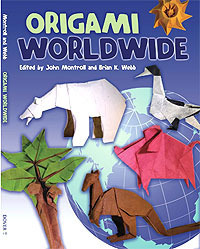 120 pp softback Dover Publications
120 pp softback Dover Publications
Origami Worldwide is a collection of models created by origami designers from around the world that John has met on his many travels. Countries represented include Australia, Bolivia, Chile, China, Canada, France, Hungary, India, Italy, Japan, South Africa, Switzerland, The Netherlands, United Kingdom, Uruguay, USA, and Vietnam.
Designers include (in order of appearance) Nick Robinson, Mark Bolitho, Nicolas Terry, Eric Joisel, Peter Budai, Sipho Mabona, Federico Scalambra, Nicoletta Maggino, Ryan Walsh, Helen Lee, John Szinger, Robert J. Lang, Miguel A. Callisaya, Patricio Kunz Tomic, Roman Diaz, Gareth Louis, Steven Casey, Quentin Trollip, Kuldip Thatte, Kamlesh Gandi, Fumiaki Kawahata, Nguyen Hung Cuong, and Kade Chan Pak Hei.
It isn't clear what each of the editors did, but the diagrams are very much up to the required standard, using shades of red and grey. They have been created based on original diagrams by the requisite creators. There are basic symbols, otherwise you're straight into folding at page ten. Whilst the models vary in complexity, it's safe to say you need to have basic folding skills in order to tackle this book. Subjects are mostly birds and animals, with a few other inanimate subjects included. You can see illustrations of all contents on John's website
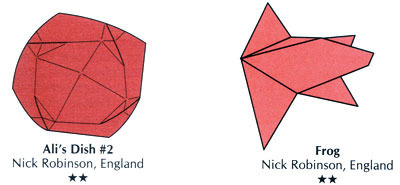 In effect, you're getting an up-market convention pack with a glossy photographic cover (in contrast to Montroll's "classic" cover style of drawn artwork). If you're after quality folding material, clearly illustrated, this will be your cup of tea.
In effect, you're getting an up-market convention pack with a glossy photographic cover (in contrast to Montroll's "classic" cover style of drawn artwork). If you're after quality folding material, clearly illustrated, this will be your cup of tea.
The cost is excellent value at around $10 in the States, or a more expensive £13.50 ($23) in the UK, so my advice is to buy it whilst on holiday in America. It's shameful how we in England get ripped off by exchange rates, but there's little to be done about it.
August 25, 2011
Unfrogettable
 I recently spotted a long-forgotten folder on my hard drive, containing some diagrams I made many moons ago, using a drawing package called Designworks. In the early 90′s, it was a superb package and I became a beta-tester for them. Dave Mitchell was another exponent. So, I thought I'd reload the diagrams and export them in a more useful format.
I recently spotted a long-forgotten folder on my hard drive, containing some diagrams I made many moons ago, using a drawing package called Designworks. In the early 90′s, it was a superb package and I became a beta-tester for them. Dave Mitchell was another exponent. So, I thought I'd reload the diagrams and export them in a more useful format.
That was when I realised the disk which said DWks3.5 actually contained something else! After some frantic emailing round to try and get hold of a copy, I had another search and found the errant CD on top of a shelf, gathering dust. It installed without hassle (displaying a "created for Windows 95″ logo) and I've managed to convert the files both to a vector format (cgm!) and hi-res jpegs. The old fonts were missing, but that wasn't an issue. I doubt I'll ever actually import the vector files into illustrator – I find it far quicker to redraw over a jpg. Anyway.
Looking through these lost models, I recognised some, but others were like a voice not heard since the mid-90s. Much of them are complete tat and will remain unpublished, but others are of pathways I was exploring but move on from. For example, here is a development of my "toad", resulting in a flat, geometric crittur. I thought this might result in a 60 degree base of some kind, oh but I was so much younger then. I'm older than that now. I'm quite surprised not to be embarrassed by the diagrams, which seem to have stood the test of time after 17 years.
[image error]
August 14, 2011
Origami to deliver? Try this!
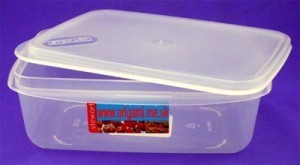 I've got some origami artwork to deliver to a client. usually, I raid the nearest supermarket for tough cardboard boxes, then customise them with a knife and gaffer tape to make a secure container. This time, I'm using my brains!
I've got some origami artwork to deliver to a client. usually, I raid the nearest supermarket for tough cardboard boxes, then customise them with a knife and gaffer tape to make a secure container. This time, I'm using my brains!
For a mere £3.99, I've bought a set of 5 re-sealable sandwich boxes, guaranteed (as much as possible) to deliver the models in pristine condition. I'll put them inside a larger cardboard box padded with newspaper, but I think this is the perfect solution for origami-preservation, plus it's cheap (always music to my Northern ears).
August 10, 2011
Neorigami – check it out…
[image error]I've posted diagrams for my "crab" on the new(!) and free Neorigami site – it looks like it will become a valuable ori-resource. The idea is you register as a creator and post photos and diagrams (if you choose to) of your work.
The diagrams themselves date from the late 80s, I haven't got round to re-drawing it, but I guess I should – they are pretty shoddy, albeit useable.
Neogami – check it out…
[image error]I've posted diagrams for my "crab" on the new(!) and free Neogami site – it looks like it will become a valuable ori-resource. The idea is you register as a creator and post photos and diagrams (if you choose to) of your work.
The diagrams themselves date from the late 80s, I haven't got round to re-drawing it, but I guess I should – they are pretty shoddy, albeit useable.

